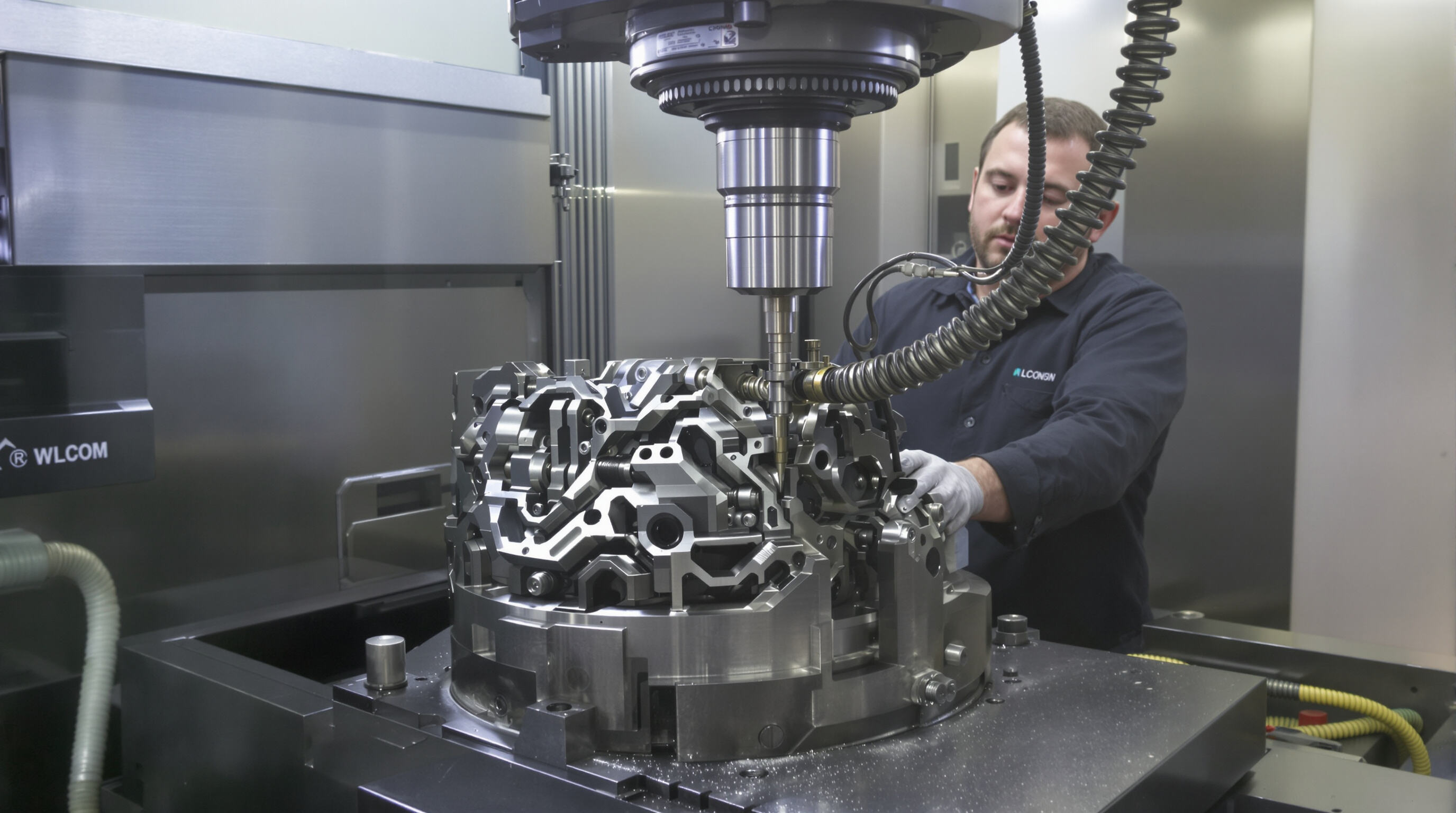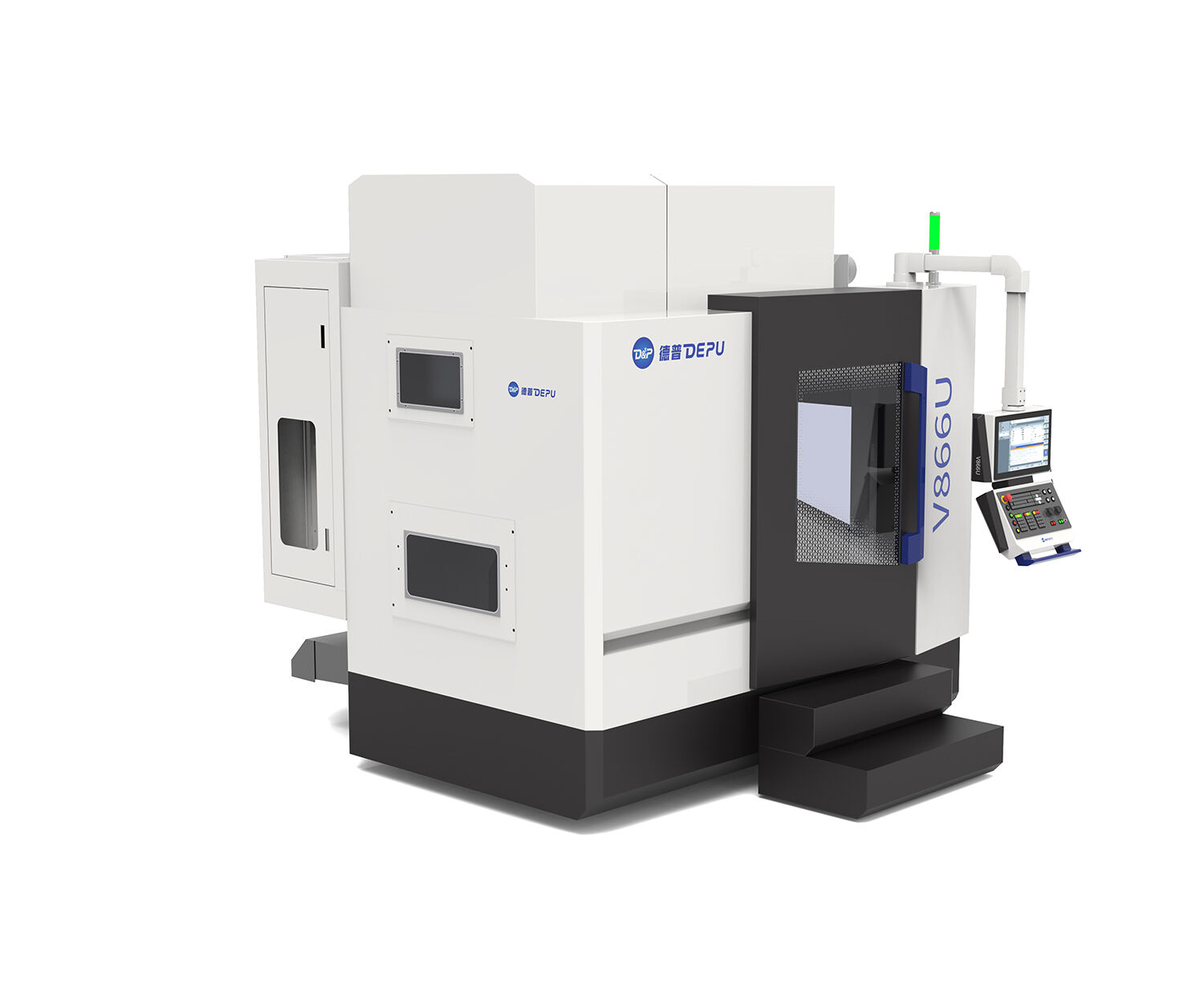วิวัฒนาการทางเทคโนโลยีเบื้องหลัง เครื่องมิลลิ่ง 5 แกน
จากการกลึง CNC แบบ 3 แกน มาเป็น 5 แกน ก้าวกระโดดทางเทคโนโลยี
การเปลี่ยนจากการกลึงแบบ 3 แกนมาตรฐาน ไปเป็นการกลึงแบบ 5 แกนที่ทันสมัยขึ้น ถือเป็นจุดเปลี่ยนสำคัญสำหรับงานผลิตชิ้นส่วนที่ต้องการความแม่นยำสูง เครื่องจักรแบบ 3 แกนรุ่นเก่าสามารถเคลื่อนที่ได้เพียงแนวเส้นตรงตามแกน X, Y และ Z เท่านั้น ซึ่งหมายความว่าช่างเทคนิคจะต้องหยุดเครื่องและปรับตำแหน่งชิ้นงานใหม่หลายครั้งเมื่อต้องทำงานที่มีรูปร่างซับซ้อน เครื่องจักรรุ่นใหม่ที่เป็นแบบ 5 แกนแก้ปัญหานี้โดยเพิ่มแกนหมุน A และ B เข้ามา ทำให้เครื่องมือสามารถเข้าถึงมุมที่ซับซ้อนได้โดยไม่ต้องเปลี่ยนการตั้งค่าหลายรอบ ตามข้อมูลล่าสุดจาก CNC Tech Insights (2023) ระบุว่า โรงงานที่ใช้เครื่องจักรเหล่านี้มีขั้นตอนการปรับตำแหน่งลดลงประมาณ 60% ทำให้สามารถตัดแต่งเส้นโค้งและพื้นที่ที่เข้าถึงยากได้อย่างต่อเนื่องโดยไม่สะดุด ความสามารถเช่นนี้คือสิ่งที่บริษัทในอุตสาหกรรมการบินและอวกาศ รวมถึงผู้ผลิตอุปกรณ์ทางการแพทย์ต้องการอย่างยิ่ง โดยเฉพาะเมื่อพวกเขามักต้องการชิ้นส่วนที่มีความคลาดเคลื่อนเพียง 0.005 มม. หรือดีกว่าสำหรับการใช้งานที่สำคัญ
ความแตกต่างหลักระหว่างความสามารถในการกลึงแบบ 3, 4 และ 5 แกน
ความแตกต่างหลักอยู่ที่ระดับอิสระในการเคลื่อนไหวและผลลัพธ์ด้านความแม่นยำ:
| ประเภทการกัด | มือ | ข้อจำกัดด้านความซับซ้อน | ประสิทธิภาพในการตั้งค่า | ช่วงความคลาดเคลื่อน |
|---|---|---|---|---|
| 3 แกน | X/Y/Z | ต่ำ-ปานกลาง | ปรับตำแหน่งใหม่ 3-5 ครั้ง | ±0.1 มม. |
| 4แกน | +1 การหมุนรอบแกน | ปานกลาง | ปรับตำแหน่งใหม่ 1-2 ครั้ง | ±0.05มม. |
| 5 แกน* | +2 การหมุนรอบแกน | สูง | การตั้งค่าเดียว | ±0.025mm |
| *การควบคุมแกนแบบพร้อมกัน |
แม้ว่าระบบ 3 แกนจะเหมาะสำหรับชิ้นส่วนปริซึม แต่เทคโนโลยี 5 แกนจะมีความได้เปรียบในการผลิตชิ้นส่วนที่ซับซ้อนและมีรูปทรงโค้ง เช่น ใบพัดกังหัน ด้วยการปรับทิศทางของเครื่องมือแบบไดนามิก
การควบคุมหลายแกนแบบพร้อมเพียงกันช่วยเพิ่มความแม่นยำได้อย่างไร
ด้วยการกลึงแบบ 5 แกนจริง (true 5 axis machining) ผู้ผลิตสามารถบรรลุระดับความแม่นยำที่น่าทึ่งในระดับไมครอน เนื่องจากทั้งห้าแกนเคลื่อนที่พร้อมกันทุกแกน ตัวเครื่องจักรจะปรับตำแหน่งของเครื่องมือตัดอยู่ตลอดเวลา เพื่อให้เครื่องมือตัดนั้นจัดแนวได้อย่างแม่นยำกับชิ้นส่วนที่กำลังผลิตอยู่ เมื่อเทียบกับระบบทั่วไปแบบ 4 แกน ซึ่งในบางการตัดนั้นจะต้องล็อกแกนหนึ่งไว้ การเคลื่อนไหวพร้อมกันทั้งหมดนี้ช่วยลดการงอหรือการเบี่ยงเบนของเครื่องมือตัด (cutting tool) ได้ดีขึ้น ซึ่งหมายถึงการควบคุมการก่อตัวของเศษชิ้นงาน (chips) ที่ดีขึ้น และช่วยลดการสั่นสะเทือนในระหว่างการใช้งาน ตามการวิจัยที่เผยแพร่เมื่อปีที่แล้วในวารสาร Precision Engineering คุณภาพของพื้นผิวที่ได้มีแนวโน้มดีขึ้นประมาณ 60 เปอร์เซ็นต์ด้วยวิธีการนี้ สิ่งที่ทำให้เครื่องจักรแบบ 5 แกนพิเศษคืออะไร? มันช่วยให้วิศวกรสามารถสร้างรูปทรงที่ซับซ้อนได้ ซึ่งเป็นไปไม่ได้ด้วยวิธีการแบบดั้งเดิม ลองคิดถึงช่องทางเกลียวภายในบล็อกเครื่องยนต์ หรือส่วนเกลียวขนาดเล็กบนอุปกรณ์ทางการแพทย์ที่ฝังเข้าร่างกาย สิ่งเหล่านี้กลายเป็นข้อกำหนดมาตรฐานในหลายอุตสาหกรรมที่ความน่าเชื่อถือของชิ้นส่วนมีความสำคัญมากที่สุด
การบรรลุความแม่นยำที่เหนือกว่าใครด้วย เครื่องมิลลิ่ง 5 แกน เทคโนโลยี

เพิ่มความแม่นยำและลดความคลาดเคลื่อนได้มากยิ่งขึ้นด้วยการปรับตำแหน่งเครื่องมือแบบไดนามิก
เครื่องกัดแบบห้าแกนสามารถลดความเบี่ยงเบนของพื้นผิวให้อยู่ต่ำกว่า 0.004 มม. เนื่องจากเครื่องสามารถปรับมุมของเครื่องมือขณะตัดผ่านวัสดุ วิธีที่เครื่องเหล่านี้จัดการแรงในการตัดช่วยป้องกันการสั่นสะเทือนที่รบกวนความแม่นยำในระบบแบบสามแกนทั่วไป เมื่อทำงานกับชิ้นส่วนไทเทเนียมสำหรับเครื่องบินที่ต้องควบคุมความคลาดเคลื่อนให้อยู่ในช่วง ±0.0005 นิ้ว การหมุนอย่างต่อเนื่องของแกน A และ B จะช่วยรักษาตำแหน่งของเครื่องมือให้ตั้งฉากสมบูรณ์กับวัตถุที่กำลังกลึง ซึ่งเป็นสิ่งที่ไม่สามารถทำได้ด้วยระบบทั่วไปที่ใช้การตั้งค่าแบบคงที่ ประโยชน์ที่ได้รับนั้นน่าประทับใจมาก ร้านค้าหลายแห่งรายงานว่าต้องใช้เวางานขัดเงาหลังการกลึงลดลงประมาณ 75% และผลิตภัณฑ์สุดท้ายยังคงรักษารูปร่างที่แม่นยำแม้บนพื้นผิวที่ซับซ้อนมาก
บทบาทของวิศวกรรมความแม่นยำในการผลิตชิ้นส่วนแบบกำหนดเองด้วยเครื่อง CNC แบบ 5 แกน
วิศวกรรมความแม่นยำช่วยให้สามารถทำงานแบบ 5 แกนได้ผ่านระบบหลัก 3 ระบบ:
- ลูกสกรูบอลแบบชดเชยความร้อนที่ให้ความแม่นยำในการตำแหน่งที่ ±2¼ม.ม.
- โครงเครื่องที่แข็งแรงทนทานช่วยลดการสั่นสะเทือนให้อยู่ต่ำกว่า 0.1g
- ระบบตอบสนองแบบเซอร์โวเรียลไทม์ที่ปรับแก้ตำแหน่งถึง 4,000 ครั้งต่อวินาที
เทคโนโลยีทั้งหมดนี้ร่วมกันทำให้สามารถควบคุมความซ้ำซ้อนของแกนการหมุนได้ภายใต้ 8 วินาทีส่วนโค้ง ซึ่งเป็นสิ่งจำเป็นสำหรับอุปกรณ์ทางการแพทย์ที่ความเบี่ยงเบนที่ระดับต่ำกว่า 5¼ม.ม. ส่งผลต่อความสามารถในการเข้ากันได้ทางชีวภาพและความทนทานในระยะยาว
ตัวอย่างงาน: การผลิตชิ้นส่วนอากาศยานที่มีความแม่นยำระดับต่ำกว่า 0.001 ม.ม.
ผู้ผลิตที่ทำงานกับใบพัดกังหันพบว่า เมื่อพวกเขาใช้เครื่องกัดแบบ 5 แกน พวกเขาจะได้ผลลัพธ์ที่น่าประทับใจมาก อัตราความสอดคล้องของชิ้นส่วนที่ทำจากโลหะผสมนิกเกิลจะเพิ่มขึ้นสูงถึงเกือบ 99.8% เครื่องจักรเหล่านี้สามารถจัดการกับร่องลึกที่ซับซ้อน 57 องศา รวมถึงรูปร่างของปีกเครื่องบิน (airfoil) ได้ในครั้งเดียว โดยไม่ต้องเคลื่อนย้ายชิ้นงาน เมื่อบริษัทไม่จำเป็นต้องติดตั้งชิ้นงานใหม่ระหว่างกระบวนการผลิตอีกต่อไป ก็จะลดจุดปัญหาหนึ่งที่สำคัญซึ่งเป็นสาเหตุของข้อผิดพลาดในการจัดตำแหน่ง สิ่งนี้อธิบายว่าทำไมพวกเขาจึงสามารถรักษาระยะความคลาดเคลื่อนที่แน่นหนามากถึง 0.0008 มิลลิเมตร แม้บนพื้นผิวโค้งที่ซับซ้อนมาก แล้วในทางปฏิบัตินั้นหมายความว่าอะไร? อัตราการทิ้งชิ้นงานเสียลดลงอย่างมากจาก 22% เหลือเพียง 0.3% เท่านั้น ซึ่งช่วยประหยัดค่าวัสดุได้มาก นอกจากนี้แต่ละล็อตยังใช้เวลาน้อยลง 40 ชั่วโมงในการตรวจสอบ ทำให้สามารถนำเวลาอันมีค่าบนพื้นโรงงานไปใช้ในงานอื่นๆ ได้
เมื่อใดที่เครื่องกัดแบบ 5 แกนจำเป็นสำหรับงานที่ต้องการความแม่นยำสูง?
เมื่อต้องจัดการกับรูปร่างที่ซับซ้อนซึ่งจำเป็นต้องเข้าถึงจากมุมที่ชันมาก เช่น ชิ้นงานที่มี undercut เกิน 45 องศา การใช้เครื่องมิลลิ่งแบบ 5 แกนจึงเป็นสิ่งจำเป็น สำหรับชิ้นส่วนที่ความคลาดเคลื่อนเล็กน้อยมีความสำคัญมากจนข้อผิดพลาดเล็กน้อยในการตั้งค่าสามารถสะสมกันเกินค่าความคลาดเคลื่อน ±0.005 นิ้ว เทคนิควิธีการแบบดั้งเดิมจะไม่เพียงพอ อีกทั้งวัสดุที่แข็งเหนือระดับความแข็ง HRC 50 ก็สร้างปัญหาเช่นกัน เพราะอาจทำให้เครื่องมือเกิดการบิดงอหากเข้าตัดไม่ถูกวิธี และพูดตามจริงแล้ว การปลูกถ่ายทางการแพทย์และชิ้นส่วนเครื่องบินจะไม่สามารถตอบสนองข้อกำหนดด้านการตกแต่งพื้นผิวได้เลย หากไม่สามารถลดค่าความหยาบเฉลี่ยให้ต่ำกว่า 0.4 ไมครอน นี่คือจุดที่การกลึงแบบ 5 แกนแสดงศักยภาพเหนือกว่าวิธีการทำงานแบบ 3 แกนทั่วไป มันทำให้สามารถบรรลุความแม่นยำสูงและการผิวเรียบเนียนที่ไม่สามารถทำได้ทีละขั้นตอนด้วยอุปกรณ์แบบดั้งเดิม
ลดเวลาการผลิตด้วยกระบวนการทำงานที่คล่องตัวขึ้น เครื่องมิลลิ่ง 5 แกน กระบวนการทำงาน

จำนวนขั้นตอนการตั้งค่าที่ลดลงในกระบวนการกลึง: หัวใจหลักของการผลิตที่รวดเร็วขึ้น
เครื่องกัดแบบห้าแกนสามารถรวมขั้นตอนการกลึงที่ต่างกันหลายขั้นตอนเข้าไว้ด้วยกันในคราวเดียว ช่วยลดเวลาในการผลิตลงประมาณ 65% เมื่อเทียบกับเทคนิคแบบสามแกนดั้งเดิม เครื่องจักรเหล่านี้ให้การเข้าถึงรูปทรงที่ซับซ้อนได้อย่างสมบูรณ์ โดยไม่จำเป็นต้องเคลื่อนย้ายชิ้นงานระหว่างกระบวนการทำงาน ซึ่งช่วยประหยัดเวลาอันมีค่า 2 ถึง 3 ชั่วโมงที่มักสูญเสียไปในการปรับตั้งค่าใหม่ ยกตัวอย่างเช่น ใบพัดกังหัน (turbine blades) ซึ่งเคยต้องใช้การตั้งค่าอย่างน้อย 4 ครั้ง ตอนนี้สามารถทำได้ภายในแค่การจับยึดครั้งเดียว การลดขั้นตอนการจัดการลงอย่างมากเช่นนี้ ทำให้โรงงานสามารถผลิตชิ้นส่วนต่างๆ ได้มากขึ้นอย่างรวดเร็ว ในขณะที่ยังคงรักษามาตรฐานด้านคุณภาพให้เท่าเทียมกันทั่วทั้งกระบวนการ
เครื่องกัดแบบ 5 แกนช่วยกำจัดความล่าช้าจากการจับยึดชิ้นงานใหม่
แกนหมุนแบบบูรณาการช่วยให้เครื่องมือสามารถเข้าถึงลักษณะทุกส่วนของชิ้นงานได้อย่างต่อเนื่องโดยไม่ต้องถอดชิ้นงานออก ช่วยลดเวลาหยุดทำงานที่เกี่ยวข้องกับการติดตั้งอุปกรณ์ลงถึง 78% (ข้อมูลอ้างอิงการกลึงปี 2024) ผู้จัดจำหน่ายชิ้นส่วนการบินรายหนึ่งสามารถลดเวลาเตรียมอุปกรณ์จาก 14 ชั่วโมงเหลือเพียง 35 นาทีหลังจากนำเทคโนโลยี 5 แกนมาใช้ ทำให้กระบวนการผลิตรวดเร็วขึ้นและมีความสม่ำเสมอสูงขึ้น
ข้อมูลเชิงลึก: ผู้ผลิตชั้นนำรายงานการลดเวลาการผลิตลง 40–70%
จากการสำรวจใน 23 อุตสาหกรรม ผู้ผลิตสามารถลดเวลาทำงานเฉลี่ยต่อรอบจาก 11.2 ชั่วโมงเหลือเพียง 3.7 ชั่วโมง โดยใช้กระบวนการทำงานแบบ 5 แกน บริษัทเครื่องมือแพทย์แห่งหนึ่งสามารถผลิตชิ้นส่วนฝังร่างกายได้เร็วขึ้นถึง 68% พร้อมทั้งรักษาระดับความแม่นยำที่ ±0.002 มม.—ซึ่งเป็นข้อกำหนดสำคัญสำหรับการปฏิบัติตามมาตรฐานของสำนักงานอาหารและยาสหรัฐฯ (FDA) ลูกค้าของผู้พัฒนาเครื่อง CNC จากเมืองเซินเจิ้นระบุว่าสามารถประหยัดเวลาได้ 40–70% จากการลดความซับซ้อนของเส้นทางเครื่องมือและเปลี่ยนเครื่องมือโดยอัตโนมัติ
การวิเคราะห์แนวโน้ม: การนำระบบ 5 แกนมาใช้มากขึ้นเพื่อการผลิตต้นแบบอย่างรวดเร็ว
85% ของโรงงานเครื่องจักรในปัจจุบันให้ความสำคัญกับระบบ 5 แกนเป็นอันดับแรกสำหรับการทำต้นแบบ ซึ่งช่วยลดระยะเวลาการวิจัยและพัฒนายานยนต์ลงได้ 6–8 สัปดาห์ จากข้อมูลปี 2023 ของสมาคมเทคโนโลยีการผลิต (AMT) ระบุว่ากว่าครึ่งหนึ่งของระยะเวลาการผลิตที่ลดลงมีสาเหตุมาจากการปรับปรุงกระบวนการทำงาน ย้ำถึงความสำคัญของเครื่องจักรแบบ 5 แกนในฐานะหัวใจหลักของกลยุทธ์การผลิตแบบคล่องตัวและแบบพอดีเวลา (Just-in-Time)
ข้อได้เปรียบหลักของเครื่องกัดแบบ 5 แกนเมื่อเทียบกับการกัดแบบ 3 แกนดั้งเดิม
ผิวสัมผัสที่ได้มีคุณภาพสูงกว่า และสามารถจัดการรูปร่างที่ซับซ้อนได้ดีกว่า
เมื่อพูดถึงคุณภาพของผิวชิ้นงานที่ได้จากการขึ้นรูปแล้ว การกัดด้วยเครื่อง CNC แบบ 5 แกนสามารถให้ผลลัพธ์ที่มีความเรียบเนียนมากกว่าระบบแบบ 3 แกนมาตรฐานประมาณสองในสามส่วน เนื่องจากเครื่องจักรสามารถรักษาองศาการสัมผัสของเครื่องมือตัดให้เหมาะสมตลอดกระบวนการตัด เมื่อทั้งห้าแกนเคลื่อนที่พร้อมกัน ช่างเทคนิคสามารถใช้เครื่องมือตัดที่สั้นกว่า ซึ่งสั่นสะเทือนน้อยกว่ามากในระหว่างการใช้งาน การสั่นสะเทือนที่ลดลงหมายถึงการเบี่ยงเบนของวัสดุชิ้นงานที่ลดลง ดังนั้นรอยเครื่องมือที่รบกวนจิตใจก็จะหายไปจากผลิตภัณฑ์สำเร็จรูป สิ่งที่เกิดขึ้นจริงคือผู้ผลิตสามารถผลิตรูปทรงที่มีความซับซ้อนแบบธรรมชาติ เช่น ใบพัดกังหัน หรืออุปกรณ์ฝังร่างกายทางการแพทย์ที่มีความละเอียดอ่อน ด้วยค่าความคลาดเคลื่อนที่ควบคุมได้ในระดับประมาณบวกหรือลบ 0.005 มิลลิเมตร รูปทรงเช่นนี้แทบจะเป็นไปไม่ได้เลยที่จะผลิตได้ด้วยเครื่องกัดแบบดั้งเดิม
อายุการใช้งานของเครื่องมือยาวนานขึ้น เนื่องจากมุมการตัดที่เหมาะสม
การรักษาระดับชิปให้คงที่และการวางแนวการตัดให้เหมาะสม ทำให้การกลึงแบบ 5 แกน ช่วยลดการสึกหรอของเครื่องมือลงได้ประมาณ 25 ถึงแม้แต่ 40 เปอร์เซ็นต์ เมื่อเทียบกับวิธีการแบบ 3 แกนทั่วไป เมื่อเครื่องมือสามารถปรับเอียงออกจากจุดที่มีความแข็งแรงสูงของชิ้นงานได้ จะช่วยป้องกันการสึกหรอของขอบที่ไม่สม่ำเสมอ สิ่งนี้มีความสำคัญอย่างมากต่อวัสดุที่มีความแข็งเกิน HRC 50 เช่น เหล็กกล้าที่ผ่านการชุบแข็ง หรืออลูมิเนียมผสมพิเศษที่ใช้ในอุตสาหกรรมการบินและอวกาศ ประโยชน์ที่แท้จริงคือสามารถผลิตชิ้นงานที่ซับซ้อนได้อย่างต่อเนื่องโดยไม่ต้องหยุดเปลี่ยนเครื่องมือ ตัวอย่างเช่นหัวฉีดน้ำมันที่ผลิตออกมาทีละชิ้นต่อเนื่องกัน และยังไม่รวมถึงการประหยัดค่าใช้จ่ายที่เกิดขึ้น ซึ่งเพียงแค่ค่าเครื่องมือเฉยๆ ก็ประหยัดได้ราวๆ 18 ถึง 32 ดอลลาร์ต่อชิ้น
การประยุกต์ใช้เชิงกลยุทธ์ในชิ้นส่วนสำหรับภาคการแพทย์และพลังงาน
เมื่อพูดถึงการผลิตอุปกรณ์เสริมสำหรับกระดูกสันหลัง เครื่องกัดแบบ 5 แกนสามารถให้ค่าความเรียบของพื้นผิวอยู่ระหว่าง 0.8 ถึง 1.6 ไมโครเมตร ซึ่งถือว่าดีมาก โดยเฉพาะเมื่อพิจารณาว่าระดับความเรียบนี้มีความสำคัญเพียงใดต่อการที่กระดูกจะรวมตัวเข้ากับอุปกรณ์เสริมได้อย่างเหมาะสม ขณะเดียวกัน เครื่องจักรเหล่านี้ยังคงความแม่นยำสูงมากที่ระดับต่ำกว่า 0.01 มิลลิเมตรตลอดกระบวนการผลิตโครงสร้างตาข่ายไทเทเนียมที่ซับซ้อน ในอุตสาหกรรมพลังงาน ผู้ผลิตพบว่าชิ้นส่วนตัวเครื่องสำหรับกังหันลมสามารถผลิตได้ในคราวเดียวแทนที่จะต้องผ่านหลายขั้นตอนบนเครื่องจักรแบบ 3 แกนรุ่นเก่า ซึ่งการเปลี่ยนแปลงนี้ช่วยลดเวลาการผลิตไปได้ราวครึ่งหนึ่ง ทำให้เกิดความแตกต่างอย่างมากเมื่อต้องจัดการโครงการขนาดใหญ่ เมื่อพิจารณาจากข้อได้เปรียบเหล่านี้ จึงไม่น่าแปลกใจที่อุตสาหกรรมต่างๆ จำนวนมากต่างพึ่งพาเทคโนโลยีแบบ 5 แกนเป็นอย่างมากสำหรับชิ้นส่วนที่แม้แต่ข้อผิดพลาดเล็กน้อยที่สุดก็อาจนำไปสู่ความล้มเหลวที่รุนแรงได้ การทำงานด้วยความแม่นยำนั้นมีความสำคัญอย่างแท้จริง เมื่อชีวิตขึ้นอยู่กับการทำงานที่เชื่อถือได้
การใช้งานจริงของ เครื่องมิลลิ่ง 5 แกน ในอุตสาหกรรมที่มีความต้องการสูง
การบินและอวกาศ: การผลิตใบพัดเทอร์ไบน์ด้วยเครื่องจักร CNC 5 แกน
วิศวกรรมการบินและอวกาศต้องการความแม่นยำสูงมากสำหรับใบพัดเทอร์ไบน์ ซึ่งมีลักษณะรูปทรงที่มีแรงยกซึ่งไม่สามารถผลิตได้ด้วยวิธีการดั้งเดิม เครื่องกลึง CNC 5 แกนช่วยให้สามารถปรับตำแหน่งเครื่องมือได้แบบไดนามิก เพื่อผลิตชิ้นงานรูปทรงซับซ้อนเหล่านี้ในขั้นตอนเดียว โดยรักษาระดับความคลาดเคลื่อนให้น้อยกว่า 0.005 มม. ความสามารถนี้มีความสำคัญอย่างยิ่งต่อประสิทธิภาพของเครื่องยนต์เจ็ทและความปลอดภัยในการบิน
การแพทย์: ความแม่นยำในการผลิตอุปกรณ์เสริมสำหรับผู้ป่วยเฉพาะรายด้วยเครื่องกัด 5 แกน
ผู้ผลิตอุปกรณ์การแพทย์ใช้เครื่องกัด CNC 5 แกนเพื่อผลิตอุปกรณ์เสริมเฉพาะบุคคล เช่น กรอบหลังคากระดูกสันหลัง และข้อต่อสะโพก การเคลื่อนไหวแบบหลายแกนช่วยสร้างชิ้นส่วนไทเทเนียมที่เข้ากันได้ทางชีวภาพ มีรูปทรงโค้งมนตามธรรมชาติ ทำให้ไม่จำเป็นต้องตกแต่งด้วยมือ ค่าความเรียบผิวต่ำกว่า 0.2µm Ra ช่วยลดการยึดติดของแบคทีเรีย ในขณะที่ความแม่นยำทางมิติภายใน ±5 ไมครอนช่วยให้มั่นใจถึงความสำเร็จในการผ่าตัด
ยานยนต์: การผลิตชิ้นส่วนกล่องเกียร์ซับซ้อนอย่างรวด็รวดเร็ว
ซัพพลายเออร์อุตสาหกรรมยานยนต์ใช้ประโยชน์จาก เครื่องมิลลิ่ง 5 แกน เพื่อเร่งการผลิตชุดเกียร์ให้เพิ่มขึ้น 45% การกลึงแบบห้าด้านพร้อมกันช่วยให้สามารถตัดช่องทางน้ำมัน ตัวยึดสกรู และจุดติดตั้งเซ็นเซอร์ได้โดยตรงโดยไม่ต้องปรับตั้งใหม่ เครื่องจักรแบบ 5 แกนเพียงเครื่องเดียวสามารถแทนที่ระบบแบบดั้งเดิม 3–4 ระบบ ทำให้สามารถผลิตชุดเกียร์ซับซ้อนได้มากกว่า 150 ชิ้นต่อสัปดาห์ โดยมีความแม่นยำตำแหน่งที่ระดับ €0.01 มม.
สารบัญ
-
การบรรลุความแม่นยำที่เหนือกว่าใครด้วย เครื่องมิลลิ่ง 5 แกน เทคโนโลยี
- เพิ่มความแม่นยำและลดความคลาดเคลื่อนได้มากยิ่งขึ้นด้วยการปรับตำแหน่งเครื่องมือแบบไดนามิก
- บทบาทของวิศวกรรมความแม่นยำในการผลิตชิ้นส่วนแบบกำหนดเองด้วยเครื่อง CNC แบบ 5 แกน
- ตัวอย่างงาน: การผลิตชิ้นส่วนอากาศยานที่มีความแม่นยำระดับต่ำกว่า 0.001 ม.ม.
- เมื่อใดที่เครื่องกัดแบบ 5 แกนจำเป็นสำหรับงานที่ต้องการความแม่นยำสูง?
- ลดเวลาการผลิตด้วยกระบวนการทำงานที่คล่องตัวขึ้น เครื่องมิลลิ่ง 5 แกน กระบวนการทำงาน
- ข้อได้เปรียบหลักของเครื่องกัดแบบ 5 แกนเมื่อเทียบกับการกัดแบบ 3 แกนดั้งเดิม
- การใช้งานจริงของ เครื่องมิลลิ่ง 5 แกน ในอุตสาหกรรมที่มีความต้องการสูง

